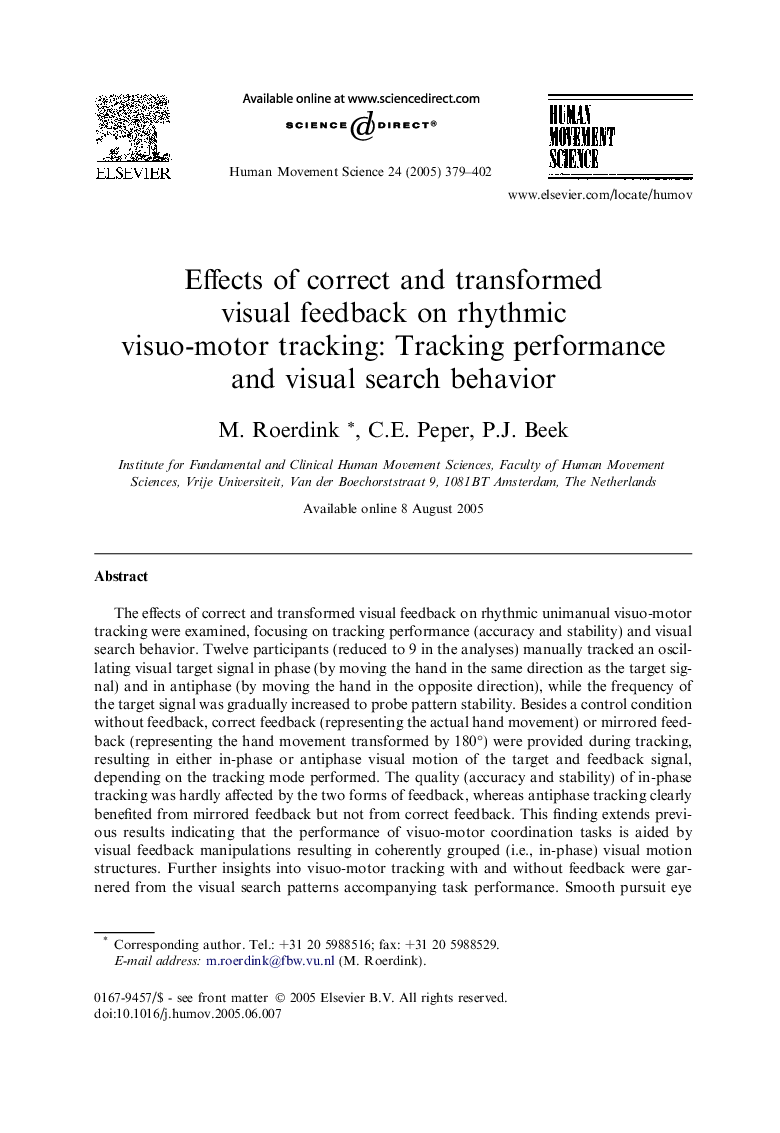| کد مقاله | کد نشریه | سال انتشار | مقاله انگلیسی | نسخه تمام متن |
|---|---|---|---|---|
| 10459330 | 922429 | 2005 | 24 صفحه PDF | دانلود رایگان |
عنوان انگلیسی مقاله ISI
Effects of correct and transformed visual feedback on rhythmic visuo-motor tracking: Tracking performance and visual search behavior
دانلود مقاله + سفارش ترجمه
دانلود مقاله ISI انگلیسی
رایگان برای ایرانیان
کلمات کلیدی
موضوعات مرتبط
علوم زیستی و بیوفناوری
علم عصب شناسی
علوم اعصاب شناختی
پیش نمایش صفحه اول مقاله

چکیده انگلیسی
The effects of correct and transformed visual feedback on rhythmic unimanual visuo-motor tracking were examined, focusing on tracking performance (accuracy and stability) and visual search behavior. Twelve participants (reduced to 9 in the analyses) manually tracked an oscillating visual target signal in phase (by moving the hand in the same direction as the target signal) and in antiphase (by moving the hand in the opposite direction), while the frequency of the target signal was gradually increased to probe pattern stability. Besides a control condition without feedback, correct feedback (representing the actual hand movement) or mirrored feedback (representing the hand movement transformed by 180°) were provided during tracking, resulting in either in-phase or antiphase visual motion of the target and feedback signal, depending on the tracking mode performed. The quality (accuracy and stability) of in-phase tracking was hardly affected by the two forms of feedback, whereas antiphase tracking clearly benefited from mirrored feedback but not from correct feedback. This finding extends previous results indicating that the performance of visuo-motor coordination tasks is aided by visual feedback manipulations resulting in coherently grouped (i.e., in-phase) visual motion structures. Further insights into visuo-motor tracking with and without feedback were garnered from the visual search patterns accompanying task performance. Smooth pursuit eye movements only occurred at lower oscillation frequencies and prevailed during in-phase tracking and when target and feedback signal moved in phase. At higher frequencies, point-of-gaze was fixated at a location that depended on the feedback provided and the resulting visual motion structures. During in-phase tracking the mirrored feedback was ignored, which explains why performance was not affected in this condition. Point-of-gaze fixations at one of the end-points were accompanied by reduced motor variability at this location, reflecting a form of visuo-motor anchoring that may support the pick up of discrete information as well as the control of hand movements to a desired location.
ناشر
Database: Elsevier - ScienceDirect (ساینس دایرکت)
Journal: Human Movement Science - Volume 24, Issue 3, June 2005, Pages 379-402
Journal: Human Movement Science - Volume 24, Issue 3, June 2005, Pages 379-402
نویسندگان
M. Roerdink, C.E. Peper, P.J. Beek,